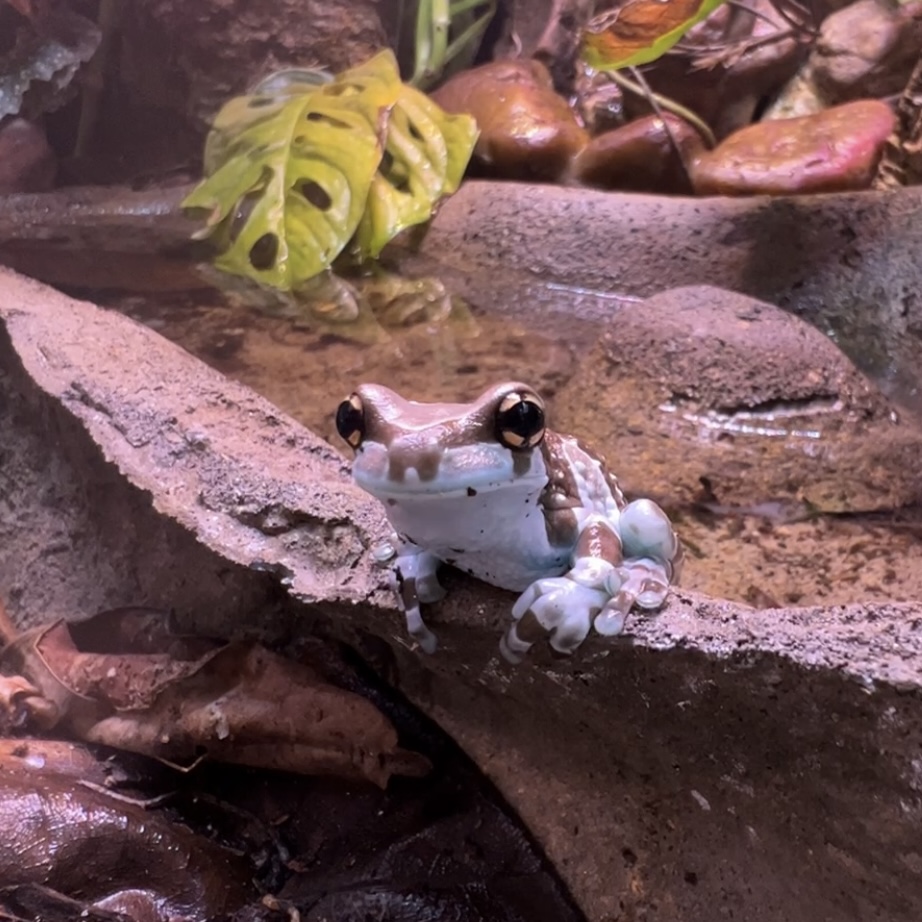CARE GUIDE
Trachycephalus resinifictrix
Amazon Milk Frogs are a large species of tree frogs – one of the largest in captivity! They are big, bold, and able to be handled when mature. Milk Frogs are visually impressive with their brown and white stripes, and blue tinted toes and belly skin caused by their blue blood! They are a GREAT beginner species for new frog keepers.
NATURAL RANGE
Brazil, Colombia, Venezuela, Trinidad, Tobago, French Guiana, British Guyana, Ecuador, Peru, and Bolivia. (Typically throughout the Amazonian Basin, below 800m in elevation)
HOUSING
Amazon Milk Frogs require a large enclosure due to their adult size. A 29g aquarium or 18x18x24 Terrarium – is a good sized enclosure for a group of 2-4 Milk Frogs. Be sure to provide plenty of perching areas, such as branches, vines, and plants (live or fake plants). They like to submerge & need a large water bowl. For younger Milk Frogs, moist paper towel or long fiber sphagnum moss is preferred. It is a good idea to provide UVB lighting for milk frogs in captivity with appropriate amphibian light fixtures. In addition to a UVB light, you can also use another fluorescent light with a more natural color temperature of 5000-6500K so that the enclosure looks more natural.
TEMPERATURE & HUMIDITY
Milk frogs are very tolerant to temperature swings, and can be kept in a range of 70-85F. Their ideal temperature is in the mid/high 70s. A 5-10F temperature drop at night is ideal. A good Thermometer and Hygrometer is recommended to keep track of environmental conditions. Adult milk frogs are hardy, but prefer humidity levels around 50-70% with plenty of ventilation. Juvenile Amazon Milk Frogs do better a bit higher 70-80% humidity with some air movement. Moist, stagnant air is dangerous for milk frogs, and very young animals dry out easily. Routine spraying and a full screen top will aid in providing proper humidity.
SIZE & LIFESPAN
Adult Amazon Milk frogs can measure from 3” to 5”, with females being larger than males. Milk frogs are thought to be able to live 8-10 years in captivity with proper husbandry.
FEEDING
Amazon Milk Frogs are voracious eaters, and will eat almost anything that will fit into their mouth. A staple diet of appropriately sized crickets is ideal, along with other feeder insects such as wax worms, roaches, horn worms, and meal worms. Feeders should be dusted in calcium/vitamin powder. Juvenile milk frogs do well on fruit flies and very small crickets.
SOCIAL BEHAVIOR
Amazon Milk Frogs do great when kept in groups. On rare occasions, males may harass females, but Amazon Milk Frogs typically coexist peacefully.
SEXING
Milk frog can usually be sexed by 8-10 months of age. Females are larger and more rotund. Males on the other hand are harder to distinguish as their vocal sacs are typically hidden by folds. Males also develop slightly swollen nupital pads on their front feet that are typically visible during the breeding season.



